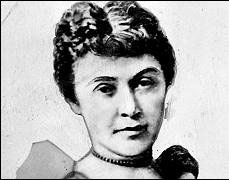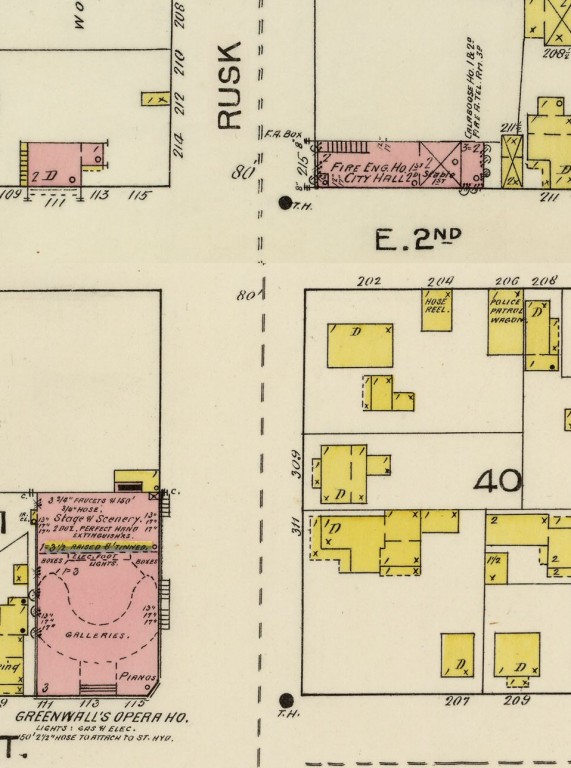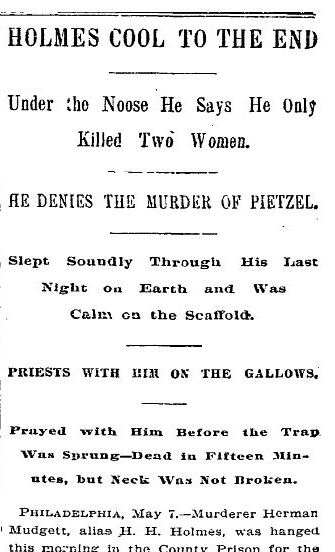Herman W. Mudgett, alias Dr. Henry Howard Holmes, was a busy man in the early 1890s: fraud, bigamy, murder. But he still found time to visit Fort Worth.

In 1892 Holmes was in Chicago, where he built a three-story brick-and-stone hotel just in time to accommodate tourists flocking to the nearby Columbian Exposition (World’s Fair). Guests checked in to the hotel. Some never checked out. The hotel was, in fact, Holmes’s dark, labyrinthine “murder castle” of sixty rooms whose gruesome functions need not be detailed here.

In 1893 Holmes came to Fort Worth, where he stole either one horse or several railroad cars of horses (depending on which account you read) and cheated Minnie Williams (pictured) out of her inheritance.
Minnie Williams had lived in Dallas and taught elocution in Midlothian before she went to Chicago and met the charming Dr. Holmes, known to her as Harry Gordon. Holmes professed his love to her (by 1894 he would have three concurrent wives, none of them Minnie and none of them aware of the other two) and finagled control of Minnie’s inheritance.

That inheritance was two hundred feet of frontage at the corner of East 2nd and Commerce streets in downtown Fort Worth. But which of the four corners? No one seems to know. Anyway, in 1894 on that property Holmes began construction of a building. A three-story brick-and-stone building. Was he building a second murder castle in Fort Worth?
 This Sanborn map shows the intersection of East 2nd and Commerce streets in 1893. The most like corner for Holmes to build on is the southwest, just north of the opera house, because it is most open. Note that one of Holmes’s neighbors at 215 Commerce (where the 1907 fire hall/150 Years of Fort Worth museum now stands) would have been city hall. Which also housed a fire hall and a police station, complete with a “calaboose” at the rear!
This Sanborn map shows the intersection of East 2nd and Commerce streets in 1893. The most like corner for Holmes to build on is the southwest, just north of the opera house, because it is most open. Note that one of Holmes’s neighbors at 215 Commerce (where the 1907 fire hall/150 Years of Fort Worth museum now stands) would have been city hall. Which also housed a fire hall and a police station, complete with a “calaboose” at the rear!
But soon after Holmes began construction of his building, he became nervous—after all, he was in Texas and wanted for horse theft—and hightailed it to a state with a higher opinion of horse thieves.
Later in 1894 Holmes was arrested in Boston (and initially held only for the Texas horse theft). Then police began sorting out their prisoner’s convoluted past and digging—literally—into his “murder castle” in Chicago. In 1895 Holmes was tried in Philadelphia for a single murder—that of Benjamin Pitezel, who, using the alias “Benton T. Lyman,” had been Holmes’s accomplice in various frauds and the supervisor of construction of Holmes’s Fort Worth building.

But Holmes was also suspected of having murdered, among others, Minnie and Nannie Williams. Both women had disappeared after Holmes got Minnie’s downtown property. Holmes claimed that Minnie had killed Nannie and that he had just dumped the body in a lake. The heirs of the sisters hired Fort Worth attorney William Capps to represent them in a civil case after Holmes claimed ownership of the Fort Worth property. In 1895 the New York Times reported on Capps’s interview of Holmes in the Philadelphia prison.
About William Capps: In the 1880s he and Samuel Benton Cantey Sr. had formed the law firm Capps & Cantey. Since Capps’s death in 1925 the firm has continued as Cantey Hanger. Capps also was editor of Fort Worth’s first morning newspaper, the Record. Capps lived in the Pollock-Capps house (1899) on Penn Street on Quality Hill.

Herman W. Mudgett, alias Dr. Henry Howard Holmes, was found guilty of just one murder and was hanged on May 7, 1896. But he had admitted to killing two people. Or four. Or twenty-seven. Or more than one hundred. His claims varied. Some researchers call him “America’s first serial killer,” believe he killed at least twenty-seven people. Again, just as with his purpose for building a three-story building at the corner of East 2nd and Commerce streets, we’ll never know.
More on Dr. Henry Howard Holmes:
Mr. Mudgett (Part 1): “I Was Born With the Devil in Me”
Mr. Mudgett (Part 2): The Quick and Slow Deaths of the Holmes Castles
Updating the Update: Behold the “Castle” of Dr. Holmes
Sidney Samuels and Henry Holmes: “The Individual in the Cage”






Very interesting to do the street view on Bing maps in the area of his supposed castle. I wonder how far along he got building it, and does any portion of it remain though renovated. On bing if you travel away from the courthouse just as you cross 2nd street the building on the right corner is a one story brick. The side of this building actually faces 2nd street and looks like architecture of that era. Possible? Who knows? I was born and raised in Fort Worth and never knew this. I will be going back there in November, and will most likely walk around that area a bit
At the bottom of that post are links to other posts on the subject with photos of the building, maps, ads of the businesses in it, and details of its final years.
1 hour documentary on Holmes tonight on History Channel entitled “American Ripper” – 9pm central time.
Had to notify you the second I stumbled upon this on my tv guide.
The title says it all. Thanks for the tip.
I too, read The Devil and the White City and was frustrated at what little information they had on Minnie and Nannie. I was fascinated how he was able to get the property from them and wondered where in Ft. Worth it was. The man truly was evil.
My research was stymied in the beginning by the Rush-for-Rusk typo in the NYT back when there was not much out there about his FW time. I was delighted to stumble across a photo showing his FW hotel.
As an avid reader of true crime books I read 2 separate books about Herman Mudgett, aka H.H. Holmes. Both books briefly mention his fraudulent real estate dealings in Fort worth. I was born and raised in Ft.Worth so when I read about this, I was very curious and interested in learning more about his dealings in my hometown. Not knowing where to go to learn more nor who to ask, I abandoned the subject. Now I am thrilled to read the entire history of holmes’s dealings in a Fort Worth. Thank you so much for doing what I wanted to for many years.
Like many people, my introduction to Holmes came from Devil. But the Fort Worth details were so sparse! Where was the Fort Worth property? That book came out in 2003, when hardly anything about Holmes was on the Internet. I did find a New York Times article from 1895 that said Holmes had tricked an heiress out of control of property in Fort Worth, Texas. Holmes, the story said, had gotten a hold of property with two hundred feet of frontage on RUSH Street. That “Rush Street” stumped me for the longest time because I could find no Rush Street in Fort Worth in the 1890s. Then one day the spirit of Vanna White came to me and hovered over my shoulder and whispered in my ear: “KAY. Try a KAY instead of an ATCH. R-U-S-K!”
Eureka!
“Rush” had been a typo in the Times story! That solved the mystery and allowed me to move forward. Rusk Street, of course, is now Commerce Street.
Now there are dozens if not hundreds of Holmes resources online. As you may know, Frank P. Geyer’s The Holmes-Pitezel Case is available online.
The Holmes story is perhaps my favorite Fort Worth story from the dozens I have researched in the last three years while writing Hometown by Handlebar and Lost Fort Worth.
Additional information about H.H. Holmes is found I. The non-fiction book, The Devil and White City.
Thanks, Gay. I am mostly interested in his Fort Worth connection, which Larson touches on only obliquely in Devil.